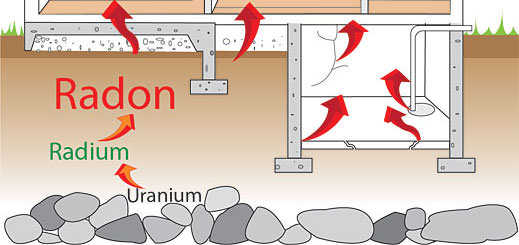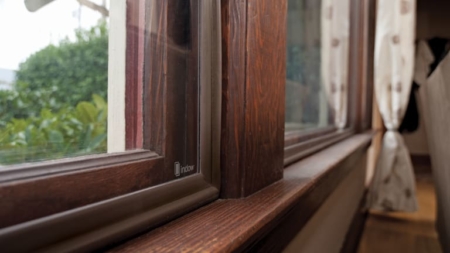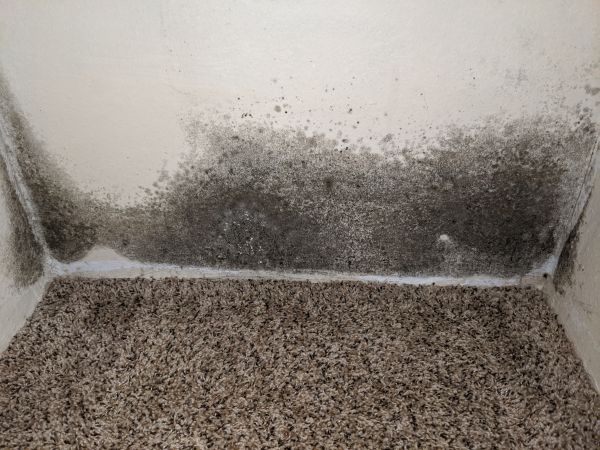Radon gas is a natural chemical element that affects the air quality inside of buildings. It is odorless, colorless, and tasteless. It forms when uranium breaks down to radium, which further breaks down to form radon. As radon decays, it releases radioactive byproducts that are inhaled into the lungs. Radon is emitted from the ground and enters a home through cracks in walls, construction joints, basement floors, solid foundations, and other openings such as gaps around pipes or around suspended floors. Less frequently, radon may enter buildings from radon-contaminated drinking water used in bathroom showers and sprays, though this occurs only when the water comes from a private well.
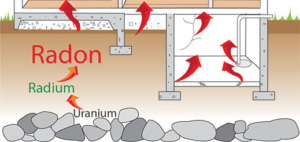
How radon enters a house
The main source of indoor radon gas is from rock and soil, so it can be found anywhere. Exposure to limited concentrations, like those found outdoors, is impossible to avoid. However, when radon gets trapped indoors, it may build up to dangerous concentrations.
According to the United States Environmental Protection Agency (EPA), radon is the second cause of lung cancer after cigarette smoking, although it is the number one cause for people who have never smoked. Radon leads to 21,000 lung cancer deaths per year in the US and 2,900 of these deaths occur among non-smokers. It is not considered a cause of Sick Building Syndrome (SBS) because it leads to long-term illness rather than symptoms that are alleviated by spending time away from the building.
Elevated radon levels inside buildings have been found in every state. The Radon Act 51 passed by Congress set the natural outdoor level of radon gas (0.4 pCi/L) as the target for indoor radon levels, however two-thirds of all homes exceed this level. The EPA set a more attainable indoor limit at 4 pCi/L, therefore homes at or above this level are highly encouraged to take action to reduce indoor radon. The World Health Organization (WHO) recommends 2. pCi/L or lower. A reduction to below 2 pCi/L is more ideal though and would likely reduce the yearly lung cancer deaths attributed to radon by 50%.
The EPA estimates that nearly one out of every fifteen homes in the US has unsafe radon levels and therefore it is recommended that every home should be tested for radon. State and county averages can be viewed at http://www.radon.com/maps/. Data on the map has been collected from Air Chek, Inc., the EPA, as well as state and county health departments. For example, Oregon’s average indoor radon level is 3.1 pCi/L. Multnomah County has an average radon level of 3.8 pCi/L (results above 4 pCi/L in the county are 29.9%), Washington County has an average radon level of 1.9 pCi/L (results above 4 pCi/L in the county are 11.3%, and Clackamas County has an average radon level of 2.9 pCi/L (results above 4 pCi/L in the county are 17.1%). Oregon.gov has an interactive map and table of radon risk levels listed by zip code.
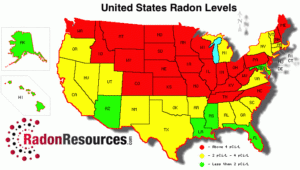
Radon Map
Radon test kits can be purchased at hardware stores or online, such as through the American Lung Association of Oregon or the National Radon Program Services. Indoor radon levels can be influenced by season, weather, geology, type of construction, and heating, ventilation, and a/c systems, thus both short and long term kits are available. Examples of prices for test kits (from the National Radon Program Services) are short term (3-4 days) test kits are $15 and long term (3-12 months) test kits are $25 (both options include shipping each way). Follow the directions on the packaging for proper placement of the testing device and where to send the device after testing to find out the home’s radon level.
The greatest risk of exposure to radon arises in buildings that are insufficiently ventilated, airtight, and have foundation leaks that allow air from the soil into dwelling rooms. To significantly reduce a building’s radon levels, seal the home or office to prevent radon from getting through cracks and other openings. A separate ventilation system may need to be installed to remove high levels of radon. Most radon problems can be fixed by a do-it-yourselfer for less than $500. Professional radon mitigators can be hired if assistance is desired or required. Baker, Clackamas, Hood River, Multnomah, Polk, Washington, and Yamhill counties in Oregon have radon mitigation requirements for new construction.
Additional online resources:
Oregon.gov: further info on how to reduce radon, possible funding assistance, as well as finding a professional.
National Radon Safety Board: finding a professional
Testing info and tips: More usefulness from Oregon.gov
Radon mitigation: including how to purchase a DIY manual
Infiltec, Inc.: DIY mitigation supplies and how-to instructions
Further info on radon:
Lung.org: http://www.lung.org/our-initiatives/healthy-air/indoor/indoor-air-pollutants/radon.html
EPA: https://www.epa.gov/radon/health-risk-radon

